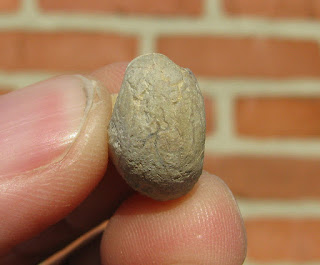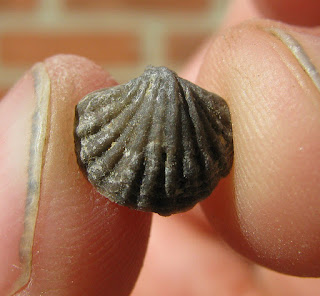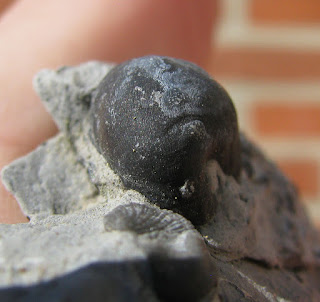Hey All, I just got back from a vacation to Texas, Oklahoma, Utah, Wyoming and Colorado and am working on cleaning and identifying my finds. Sorry for the lack of updates but I will be back in a week or two with new content. In the meantime, enjoy some scenery from the places I visited.
Ammonite in North Texas
Bois d'Arc formation in Oklahoma
Green River formation in Kemmerer, WY
Neozoic Rhyolite flows with Geodes from Dugway, UT
Weeks formation, limestone near Delta, UT
Marjum formation near Delta, UT
Green River formation Douglass Pass, Colorado
An old fossil on top of Pikes Peak, Colorado
Monday, September 14, 2015
Saturday, September 5, 2015
Coenholectypus planatus echinoid from the Walnut formation of Texas
This round echinoid is Coenholectypus planatus echinoid from the Walnut formation of Texas (Cretaceous, Albian stage). It is one of many that I have received from a friend who collects in the Lone Star State. The test is round when viewed from the dorsal or ventral sides and shaped like a dome when viewed from the sides. In like it would have been covered with many small spines, the bases of which you can see preserved. I think this is considered a "regular" echinoid due to it's shape. Based on the shape of the test and small spine bases I think that C. Planatus would have lived in the littoral zone in rocky and sandy areas.
Adoral surface
Profile views
Oral surface
Adoral surface
Profile views
Oral surface
Thursday, September 3, 2015
Placopecten clintonius pelecypod from the Yorktown formation of Virginia
This shell was among a number of Chesapectin jeffersonius specimens and it caught my eye due to the difference. A little research leads me to believe that this is a Placopecten clintonius pelecypod as it exists within the Yorktown formation at the same horizon as C. jeffersonius. The shell is smaller than C. jeffersonius and the radial ribs are both more numerous and finer.
This specimen came from the Yorktown Formation, which is Neogene in age (Pliocene epoch, Zanclean stage), along the James River in Virginia.
This specimen came from the Yorktown Formation, which is Neogene in age (Pliocene epoch, Zanclean stage), along the James River in Virginia.
Tuesday, September 1, 2015
Chesapectin jeffersonius pelecypod from the Yorktown formation of Virginia
I acquired this shell at a rock/fossil/mineral show this past spring from someone who collected it themselves. It's a Chesapectin jeffersonius pelecypod from the Yorktown formation (Neogene, Pliocene epoch, Zanclean stage) of Virginia and was found along the James River. The shell is enormous and I can just imagine what the scallops would have tasted like! It's only a single valve, I'm not sure if it is the left or the right but was a host to some epibionts. There are large barnacles (Balanus concavus), barnacles spats and some corals (Septastrea marylandica). All in all it's a terrific specimen that gives evidence of the environment that it lived in.
Shell exterior
Shell interior
I think these small holes are the traces from the boring sponge Cliona sp.
A better view of the huge barnacles
and some shots of the corals.
Corals with Cliona sp. boring sponge traces
Shell exterior
Shell interior
I think these small holes are the traces from the boring sponge Cliona sp.
A better view of the huge barnacles
and some shots of the corals.
Corals with Cliona sp. boring sponge traces
Sunday, August 30, 2015
Sellithyris sella brachiopod from the Clape Massif of France
I really like the look of this next Brachiopod. It's a Sellithyris sella from the Aptian stage of the Cretaceous (found at the Clape Massif near Narbonne, France) that has part of the shell replaced by the "mineral" Beekite (which is a variety of Chalcedony, itself a variety of Quartz). That and the colors of the shell give it a lot of visual interest beyond the shell itself.
Sellithyris sella is a terebratulid brachiopod that is oval in shape when viewed from the top or bottom.It has a beak with a round foramen on the pedicle valve. Both valves are smooth and convex with a simple "w" shaped fold and sulcus structure on the anterior margin.
Pedicle valve
This fossil reminds me of another terebratulid brachiopod called Cererithyris arkelli but that species lived during the Bathonian stage of the Jurassic, about 50 million years apart.
Sellithyris sella is a terebratulid brachiopod that is oval in shape when viewed from the top or bottom.It has a beak with a round foramen on the pedicle valve. Both valves are smooth and convex with a simple "w" shaped fold and sulcus structure on the anterior margin.
Pedicle valve
This fossil reminds me of another terebratulid brachiopod called Cererithyris arkelli but that species lived during the Bathonian stage of the Jurassic, about 50 million years apart.
Friday, August 28, 2015
Two gastropod steinkerns from the Lime Creek formation of Iowa
I found two gastropod steinkerns in my collection of Lime Creek Formation fossils from Rockford fossil Park in Iowa. They caught my attention as I was sorting the fossils I have from there to find duplicates I could send to a friend in Germany.
The first specimen is a Bellerophon sp. steinkern. Gastropods of this genera generally have a wide flaring opening to the body chamber and the shell whorls imbricate (directly overlap) upon themselves. The flared portion of the shell is missing on this steinkern but the whorls are imbricated.
Anterior view
Left side profile
Posterior view
Dorsal view
Ventral view
The other steinkern specimen is a gastropod called Floydia sp. whose whorls are not imbricated but appear stacked on top of each other. As this is an internal steinkern it is impossible to tell if the genera is correct much less determine the species.
Left profile
Anterior view
Dorsal view
Ventral view
Both of these specimens come form the late Devonian aged Lime Creek formation (Fransian stage).
The first specimen is a Bellerophon sp. steinkern. Gastropods of this genera generally have a wide flaring opening to the body chamber and the shell whorls imbricate (directly overlap) upon themselves. The flared portion of the shell is missing on this steinkern but the whorls are imbricated.
Anterior view
Left side profile
Posterior view
Dorsal view
Ventral view
The other steinkern specimen is a gastropod called Floydia sp. whose whorls are not imbricated but appear stacked on top of each other. As this is an internal steinkern it is impossible to tell if the genera is correct much less determine the species.
Left profile
Anterior view
Dorsal view
Ventral view
Both of these specimens come form the late Devonian aged Lime Creek formation (Fransian stage).
Wednesday, August 26, 2015
Coelospira concava or Atrypina imbricata brachiopod from the Kalkberg formation of New York
This is the last fossil that I am profiling from the Kalkberg formation for now. I'm very surprised at the number of species that I found from this formation considering that I have only visited it once and only at a single roadcut. The honor of being last goes to a mystery brachiopod. The shell is semielliptical with a convex pedicle valve and concave brachial valve. Both valves have very strong plications but no fold/sulcus structure. There are prominent growth lines visible towards the edges of the margins. The pedicle valve appears to have a beak and umbo.
Pedicle valve
Anterior
Brachial valve
Posterior
Profile
Hall lists two species that look similar to the above fossil, Leptocoelia concava (since updated to Coelospira concava) and Leptocoelia imbricata (Since updated to Atrypina imbricata), in the "Paleontology of New York", Vol 3, pg. 245-246, pl. 38, fig. 1-13. Based on the pictures in that volume I am inclined to call my fossil Atyrpina imbricata due to the presence of the growth lines which is indicative of the species.
This specimen was collected from the Kalkberg formation (Devonian, Lockhovian to Pragian stage) at a roadcut near Schoharie, NY.
Pedicle valve
Anterior
Brachial valve
Posterior
Profile
Hall lists two species that look similar to the above fossil, Leptocoelia concava (since updated to Coelospira concava) and Leptocoelia imbricata (Since updated to Atrypina imbricata), in the "Paleontology of New York", Vol 3, pg. 245-246, pl. 38, fig. 1-13. Based on the pictures in that volume I am inclined to call my fossil Atyrpina imbricata due to the presence of the growth lines which is indicative of the species.
This specimen was collected from the Kalkberg formation (Devonian, Lockhovian to Pragian stage) at a roadcut near Schoharie, NY.
Monday, August 24, 2015
Paleschara or Leioclesma bryozoans from the Kalkberg formation of New York
These little bryozoan "chips"were interesting to find and I'm trying to figure out what genera they are. They bear a resemblance to Paleschara sp. but they are not encrusting a shell, which is how I find them most often. they could also be another genera called Leioclesma sp. which looks similar but does not have the encrusting habit. Both of the below specimens did start out colonizing a small hard surface with the first specimen growing over an ossicle from a crinoid stem.
Specimen #1 - Dorsal surface
Profile view showing just how flat this fossil is.
Ventral surface
Specimen #2 - It's not as clear as to what the second specimen settled on. It could be a fragment of another bryozoan or possibly an ostracod carapace. Dorsal surface
Ventral surface
Both of these specimens were collected from the same roadcut near Schoharie, NY from the Kalkberg formation (Devonian, Lockhovian to Pragian stage).
Specimen #1 - Dorsal surface
Profile view showing just how flat this fossil is.
Ventral surface
Specimen #2 - It's not as clear as to what the second specimen settled on. It could be a fragment of another bryozoan or possibly an ostracod carapace. Dorsal surface
Ventral surface
Both of these specimens were collected from the same roadcut near Schoharie, NY from the Kalkberg formation (Devonian, Lockhovian to Pragian stage).
Saturday, August 22, 2015
Platyceras sp. gastropod from the Kalkberg formation of New York
I've found a few gastropod fossils in the Kalkberg formation that are well preserved, which seems to be typical for most NY Devonian material. The below three specimens all appear to be Platyceras sp. with the first two looking very similar to each other.
Specimen #1
Specimen #2 - a part of the shell is broken and missing and that truncates the outer spiral.
Specimen #3 - This specimen is larger than the other two and may just be an older representative of the same species. The coil is covered with matrix so I can't see if it's similar to the other two examples.
All three specimens were collected from the same roadcut near Schohaire, NY from the Kalkberg formation (Devonian, Lockhovian to Pragian stage).
Specimen #1
Specimen #2 - a part of the shell is broken and missing and that truncates the outer spiral.
Specimen #3 - This specimen is larger than the other two and may just be an older representative of the same species. The coil is covered with matrix so I can't see if it's similar to the other two examples.
All three specimens were collected from the same roadcut near Schohaire, NY from the Kalkberg formation (Devonian, Lockhovian to Pragian stage).
Subscribe to:
Comments (Atom)

























































